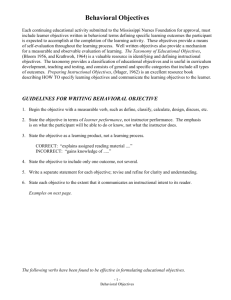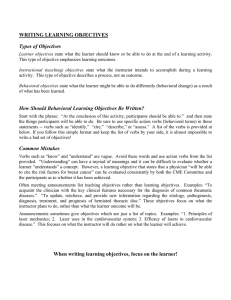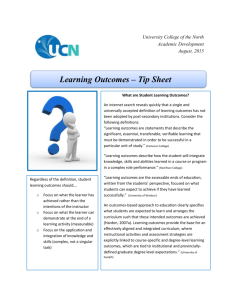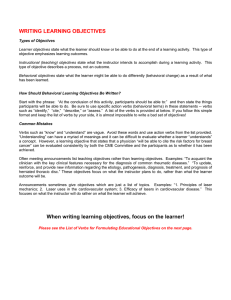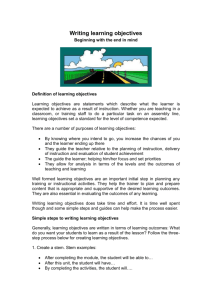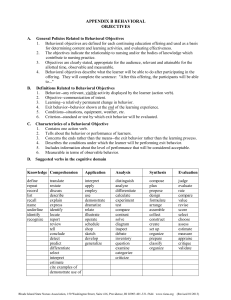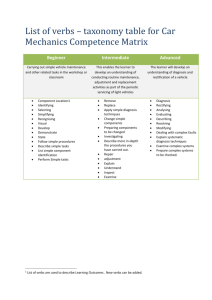Microsoft Word - writing learning objectives list of words
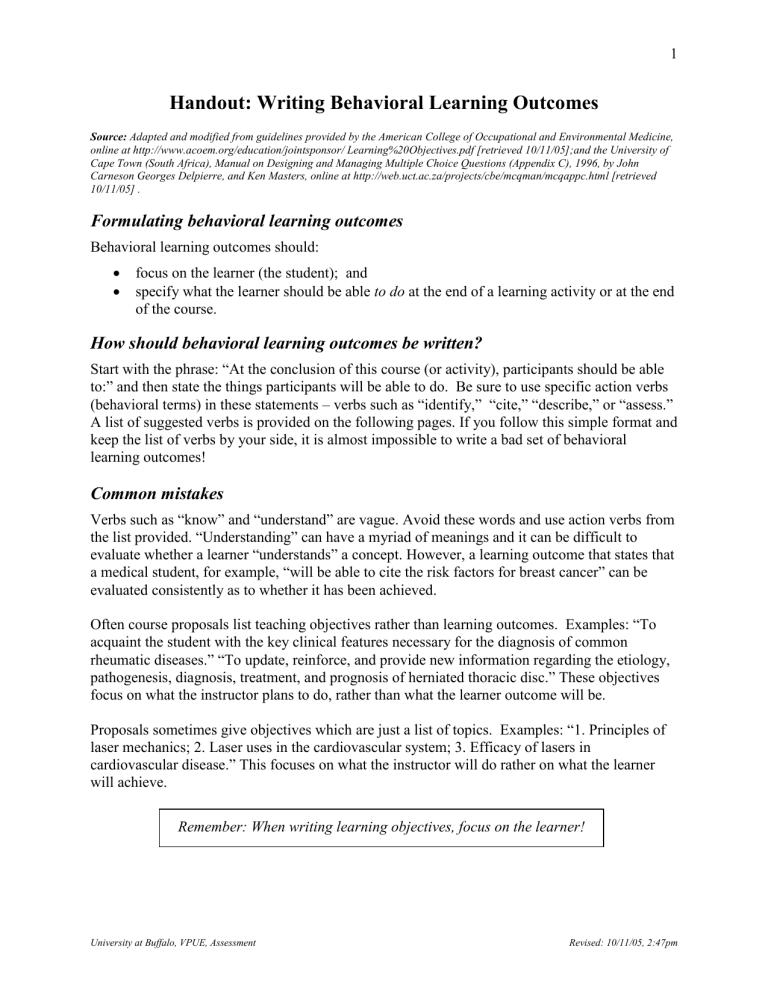
1
Handout: Writing Behavioral Learning Outcomes
Source: Adapted and modified from guidelines provided by the American College of Occupational and Environmental Medicine, online at http://www.acoem.org/education/jointsponsor/ Learning%20Objectives.pdf [retrieved 10/11/05];and the University of
Cape Town (South Africa), Manual on Designing and Managing Multiple Choice Questions (Appendix C), 1996, by John
Carneson Georges Delpierre, and Ken Masters, online at http://web.uct.ac.za/projects/cbe/mcqman/mcqappc.html [retrieved
10/11/05] .
Formulating behavioral learning outcomes
Behavioral learning outcomes should:
focus on the learner (the student); and
specify what the learner should be able to do at the end of a learning activity or at the end of the course.
How should behavioral learning outcomes be written?
Start with the phrase: “At the conclusion of this course (or activity), participants should be able to:” and then state the things participants will be able to do. Be sure to use specific action verbs
(behavioral terms) in these statements – verbs such as “identify,” “cite,” “describe,” or “assess.”
A list of suggested verbs is provided on the following pages. If you follow this simple format and keep the list of verbs by your side, it is almost impossible to write a bad set of behavioral learning outcomes!
Common mistakes
Verbs such as “know” and “understand” are vague. Avoid these words and use action verbs from the list provided. “Understanding” can have a myriad of meanings and it can be difficult to evaluate whether a learner “understands” a concept. However, a learning outcome that states that a medical student, for example, “will be able to cite the risk factors for breast cancer” can be evaluated consistently as to whether it has been achieved.
Often course proposals list teaching objectives rather than learning outcomes. Examples: “To acquaint the student with the key clinical features necessary for the diagnosis of common rheumatic diseases.” “To update, reinforce, and provide new information regarding the etiology, pathogenesis, diagnosis, treatment, and prognosis of herniated thoracic disc.” These objectives focus on what the instructor plans to do, rather than what the learner outcome will be.
Proposals sometimes give objectives which are just a list of topics. Examples: “1. Principles of laser mechanics; 2. Laser uses in the cardiovascular system; 3. Efficacy of lasers in cardiovascular disease.” This focuses on what the instructor will do rather on what the learner will achieve.
Remember: When writing learning objectives, focus on the learner!
University at Buffalo, VPUE, Assessment Revised: 10/11/05, 2:47pm
List of suggested verbs for formulating behavioral learning outcomes
The following verbs parallel Bloom’s (1956) taxonomy outlining levels of cognitive learning.
The taxonomy represents a hierarchy from the lowest-level cognitive skills (knowledgerelated) to those at the highest level (evaluation-related).
Knowledge: remembering previously learned material
Cite
Count
Define
Identify
Indicate
List
Quote
Read
Recite
Relate
Repeat
Select
Tell
Trace
Write
Describe
Draw
Name
Point
Recognize
Record
State
Tabulate
Comprehension: ability to grasp the meaning of material
Associate Describe Explain Locate
Classify
Compare
Differentiate
Discuss
Express
Extrapolate
Predict
Report
Translate
Compute
Contrast
Distinguish
Estimate
Interpolate
Interpret
Restate
Review
Application: ability to use information in new and concrete situations
Apply Employ Locate Relate
Calculate
Complete
Examine
Illustrate
Operate
Order
Report
Restate
Demonstrate Interpolate
Dramatize Interpret
Practice
Predict
Review
Schedule
Sketch
Solve
Translate
Use
Utilize
Analysis: ability to break down material into component parts to understand its structure
Analyze Debate Distinguish Inventory
Appraise
Contract
Criticize
Detect
Diagram
Differentiate
Experiment
Infer
Inspect
Question
Separate
Summarize
Synthesis: ability to put parts together to form a new or original whole
Arrange
Assemble
Construct
Create
Formulate
Generalize
Organize
Plan
Collect
Compose
Design
Detect
Integrate
Manage
Prepare
Prescribe
Produce
Propose
Specify
Evaluation: ability to judge the value of material based upon definite criteria
Appraise Determine Judge Recommend Test
Assess
Choose
Critique
Estimate
Evaluate
Grade
Measure
Rank
Rate
Revise
Score
Select
Bloom, Benjamin S., & Krathwohl, David R. Taxonomy of Educational Objectives: The Classification of Educational Goals, by a committee of college and university examiners. Handbook I: Cognitive Domain . New York, Longmans, Green, 1956.
2
University at Buffalo, VPUE, Assessment Revised: 10/11/05, 2:47pm
